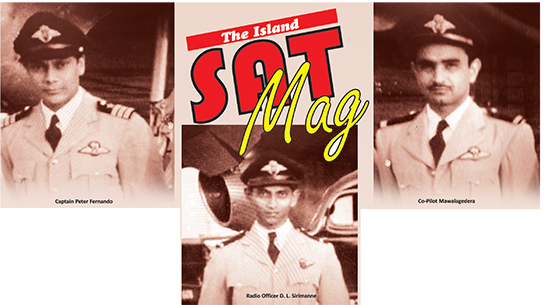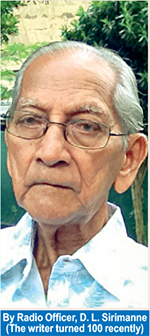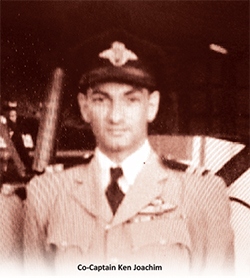An epic Air Ceylon charter flight in late 1940s-by D.L Sirimanne

Source:Island
The comprehensive and interesting article written by Capt. Elmo Jayawardena in The Island newspaper of 06 October 2020 under the title, ‘First Pilgrimage to Mecca by Air,’ described the daring flying capabilities of the Ceylonese pilots with limited navigational facilities when Civil Aviation commenced in Ceylon in 1947.
The final pilgrimage to Mecca by Air Ceylon was to take a group of pilgrims organised by Adamjee Lukmanjee family and friends not only on pilgrimage to Mecca but also on a tour to Cairo and Damascus.
The crew consisted of Capt. Peter Fernando, Co-Pilot. P.B. Mawalagedera, Co-Capt. Ken Joachim, Radio officer D. L. Sirimanne and Flight Engineer G. V. Perera.
The Ratmalana Airport was chock-a-block with well wishers, relations and friends. The pilgrims were all dressed in white. The DC3 aircraft had 21 slumber lounge seats for luxury travel. The aircraft loaded to full capacity finally took off on a beautiful clear morning and set course to Bombay on its first lap. It was a four-and-a-half-hour flight flying at 8,000 feet. Approaching the Indian air space, we were cleared to ascend to 12,000 feet to fly over the Western Ghats. Heavy cloud formations were encountered. Fasten-seat-belts warning was switched on and the aircraft got enveloped in thick clouds; the flight became extremely bumpy, rough and turbulent. Down drafts almost sucked the passengers off their seats. It lasted for about half an hour and then the plane shot out to blue skies and steady smooth flying again to the joy of the frightened passengers and landed at Bombay for refueling.

The passengers were relieved to stretch their legs and attend to toilet facilities at the airport. Lunch was served and when ready took off to Karachi, a three-and-a-half-hour flight. The weather was superb. Nearing Karachi, the evening sky became hazy turning red in the setting sun. The famous R 101 Hangar at Karachi Airport was visible from as far as 70 miles which was a useful navigational aid for homing. It was a huge aluminum roofed hangar which reflected the setting sun like a glistening star. It was built in 1929 for the R 101 Airship to fly long distance in the British Empire, but on its maiden flight from England, crashed over France killing the crew and passengers. On landing at Karachi, the BOAC agent took the passengers and crew for a night stop to their BOAC ‘Speed Bird’ transit hotel at the Karachi Airport similar to the KLM ‘Midway House.’ It had comfortable rooms with sleeping and toilet facilities and attendants at the press of a button. A sumptuous biriyani dinner was served.
Early next morning after breakfast, we left Karachi and headed over the sea to Salalah on the Arabian Coast. The five-hour flight was smooth and uneventful and we landed at Salalah for fueling. Since it was midday, the lunch packets and drinks loaded at Karachi were served on ground. Refreshed, we took off and did a five hours flight in clear weather and landed at Aden for a night stop. Aden was beastly hot and unbearable. The BOAC staff welcomed us and took the passengers and crew to a comfortable hotel in the city centre for the night.
Early in the morning, we took off, and after a three-hour flight landed in Jeddha, a busy transit airport for Hajj pilgrims to Mecca. The Adamjees thanked us and bid farewell on their journey to Mecca on a Saudi Airline as foreign aircraft were forbidden to operate to Mecca. We returned empty to Aden for a three-day stay. To our annoyance, the Aerodrome Control instructed us to park in a remote area far from the normal parking bay. Three miserable days later we left Aden and arrived in Jeddah. The pilgrims having finished their rituals at the sacred Kaaba in Mecca were gleefully waiting excitedly to tour famous Cairo and Damascus. The leader of the party had brought two large barrels of Holy Water and requested they be loaded. Capt. Fernando politely refused to take them as the aircraft was loaded to capacity and suggested they be shipped to Colombo.
The BOAC Representative informed that it was a mandatory requirement for passengers visiting Cairo from Jeddah and South Africa to spend three days quarantine in El Tor as a precaution against Yellow Fever. On the navigation chart we observed it was almost on our heading to Cairo. The four-hour flight was uneventful and we homed on El Tor NDB. We got landing instructions and the runway was an improvised airstrip marked with white painted stones and a small building at the end. We landed and taxied to a camp spread in front of the building which, we later learnt, was a base hospital with spacious tents for accommodation.
After immigration formalities, we were taken over by a Medical Officer and a batch of nurses who attended to the passengers, and the crew was taken to a separate tent with beds, enclosed toilets and shower facilities. A little later, a nurse in uniform gave each of us a test tube with a small piece of wire tipped with a swab of cotton and a small bottle for specimens of feces and urine. After a while she came back with a tray to take them. We were unable to have them ready and requested her to come in the evening. She was furious and returned with a bulky health officer who asked us to comply immediately. Otherwise, he would be compelled to take samples by force. We had to give in as we did not like anyone poking wires into our anuses and requested a little more time. Our Flight Engineer G.V. Perera said he has an inclination and retired to the toilet. He came back with his test tube full. We shared what he brought amidst peals of laughter. The nurse came and took the samples away. We all chuckled. What if G.V’s had anything infectious? All of us would have been in quarantine for a longer period!

We were made comfortable during the three days with food, drinks and listening to the blare of Egyptian music and songs on a loudspeaker broadcast for the whole establishment. The nights were cool although no trees were within sight. There was a billiard table that kept us in good spirit. Three agonizing days in the sweltering desert heat dragged by and finally were given a Clean Bill of Health to proceed to Cairo.
El Tor airport had no control tower but only a cabin. Peter asked me to get flight clearance from the Controller. The Controller said he could not do it as Cairo was in fog. After an agonising wait of more than two hours, clearance was granted. It was a tricky take off from that short sandy runway in the desert. I held my breath with prayer as we just managed to clear the end of the runway on full power; luckily there were neither trees nor high obstructions to fly over. After an hour’s flight we landed in Cairo, a huge busy international airport with modern navigational and landing facilities. The fog had dissipated, the temperature was rather cool compared to Aden and Jeddah.
The BOAC handling agents cleared formalities and took over the passengers to a hotel, and the crew to Shepherds, where international flight crews stayed. A magnificent hotel built by the British during their occupation of Egypt to accommodate royalty and other dignitaries including King Farouk of Egypt. The hotel was like an Egyptian palace with huge pillars painted red and gold and even the rooms were large with high ceiling and huge king-size beds. The ornate lobby had a palatial atmosphere and the waiters were six-foot Nubians in colorful robes. The hotel was located overlooking a broad avenue where thousands of cars roared past without sounding their horns, a continuous mushy sound indicating how busy modern Cairo was. The food was delicious and served with wine. One had to be in full dress for dinner and we went in our Gabardine ceremonial uniforms.
The following morning, we visited the famous Cairo Museum, a vast building and saw the Mummies of King Tutankhamen and Queen Nefertiti and a huge collection of ancient artifacts of ancient Egypt and then ended with a boat ride on the Nile. There were many interesting places to visit in Cairo and further south. In the afternoon, we motored to a hotel in Giza to see the Pyramids. We hired a tour guide and six camels, one each with its keeper. I was the last to follow the batch. Half way, the camel suddenly sat on its belly and wouldn’t move. I shouted to the rest of the crew to stop and help me, but they didn’t hear and I felt frightened to be left alone with the camel keeper in the desert. He tried everything possible for the camel to get up but it wouldn’t. Then the camel keeper asked me for some ‘buckshee’ (money) and in desperation I gave him a few Egyptian pounds. He tucked it into his waist and fed something to the camel. Suddenly, it rose to its feet and started trotting at speed to follow the rest. The Pyramids are made of massive blocks of stone and there were several of them in the distance. The biggest was next to the Sphinx. We got down and there was a large hole at the base of the pyramid and we climbed within, one behind the other, an unending ladder leaning at about 40 degrees. It was dark and each was given a torch and, on all fours, we reached the middle chamber of the pyramid and strangely there was a ray of sunlight. There were empty ornate royal coffins or sarcophagus, lots of statues, and other ancient relics in it. A little while later we started descending until we came out into bright sunshine, which hurt our eyes.
In the afternoon while we were in the spacious verandah of the hotel watching the rich visitors who come to the hotel, a Muslim gentleman visited us and introduced himself as Majeed, a Ceylonese businessman owning a jewellery shop opposite the hotel. He had heard some Ceylonese had arrived and are staying in the hotel. We told him that we were an Air Ceylon crew bringing a group of Muslims on pilgrimage to Mecca and they are touring Cairo for a couple of days. He was delighted to meet us. We ordered tea. While chatting, Majeed said he had heard there was a high-level diplomatic conference at the hotel that afternoon and the Prime Minister Jawaharlal Nehru and Prime Minister D. S. Senanayake were expected to arrive here on their way after attending a Commonwealth Prime Ministers Conference in London.
It was wonderful news and we waited anxiously to meet our PM. Little later Mr. Senanayake with two gentlemen arrived, and Capt. Peter Fernando went and greeted our PM with due respect and invited him to join us. Senanayake was surprised to meet Ceylonese in Cairo, and when told that we are Air Ceylon crew flying a group of Muslim pilgrims to Mecca and touring Cairo and Damascus, he congratulated us. There was a commotion and Jawaharlal Nehru arrived with a large retinue. Our PM wished us goodbye and joined them.
It was the time King Farouk was forced to abdicate and Abdul Nasser had taken over the government. The British were sent out of Egypt and the Suez Canal was taken over. Our Co- Capt. Ken Joachim, a fair Burgher in Gabardine uniform looked handsome like a British military officer. He had seen a beautiful French sales girl in a perfume shop nearby and would go on the pretext of buying some perfume. The police had stopped him and questioned him as to what he was doing in Cairo. When told he is a pilot from Ceylon bringing some tourists, they let him go. Ken got scared the Egyptians would lynch him mistaking him for a Britisher, begged me to chaperon him when visiting the perfume shop. On the last day in Cairo he bought a bottle of perfume for his wife. A message was received the passengers were ready to proceed to Damascus. We took off from Cairo at noon the following day and after a three-hour flight landed in Damascus.
Damascus is the capital of Syria. Due to turmoil in the Middle East, the Damascus Airport was full or fighter planes and soldiers. The passengers and crew were cleared and taken over by a BOAC Officer to a hotel in the centre of Damascus. Something amusing happened there; a high-ranking Air Force officer at the airport with lots of medals asked Captain Peter Fernando, from which country we were from. When told from Ceylon, he was surprised for he thought Ceylon was part of India. He wanted to know how many planes Air Ceylon had. Peter without batting an eyelid lied: ‘We have six DC4s, ten DC3s and we operate to cities in India and East.’
The pleasant and amiable BOAC Officer visited us that evening and took us to dinner at a restaurant in the Damascus City Square and then to a nightclub. It looked like a dark little den, crowded with Syrians in their traditional dress and seated on cushions on floor, smoking hookah. The air was pungent with a strong tobacco smell. We were distinguished guests and being foreigners, given front row seats. A waiter wearing tiny cups around his belt would stoop down gracefully filling the cup with strong spicy coffee from the container strapped on his back and a brass tube curved over shoulder with the snout offered coffee free on request.
Loud Syrian music by a band of musicians started playing and with a rousing applause, a fair young buxom Syrian beauty appeared on the stage scantily dressed in a sequined bra and flimsy colorful veils hanging from her waist covering a sexy bottom and shapely legs she danced her belly and hips in an erotic rhythm displaying shapely thighs, and the audience applauded with delight. Most of them were bearded old men. While dancing she snatched a veil from her waist revealing a bit of her pubic region and threw it to the audience who grabbed it gleefully throwing money to the stage. One by one while dancing she removed leaving the last to cover her nudity. The crowd in ecstasy screaming wildly threw more money at her feet. The dance went on and suddenly she coyly removed her bra, revealing beautiful dancing breasts with pink nipples, and threw it to our group. The audience was in raptures. Our amiable BOAC Officer caught it quickly and threw it back to the stage with a handful of money and hastily took us out saying she expected a night out with us.
The following morning, we went on a conducted tour of Damascus. The place that interested me most was the window in the Wall of Damascus, where St. Paul escaped in the night from certain death and fled to Jerusalem. We entered the massive market called ‘Souq’ in Arabic, is a labyrinth of passages lined with shops under one vast roof where one could get lost. Bargaining was a customary ritual. It had a variety of merchandise including beautiful clothing, genuine Persian carpets, gold, jewellery, perfume etc. I bought an attractive brocade dressing gown. Peter was looking for wartime medals, especially the “German Iron Cross,’ a medal given by Hitler for bravery. He tried to take a snap of some beggars and the police snatched the camera saying photography was prohibited. Probably, they did not want the world to know that poverty prevailed in Syria.
After three days of sightseeing, the Adamjees were ready to get back home and so were we. We flew to Sharjah for refuelling and then to Karachi for a night stop. The next morning, we took off, had lunch in Bombay and reached Ratmalana in the evening where crowds were waiting to receive the pilgrims with garlands. Thus, ended a memorable and exciting adventurous flight.








No Comments